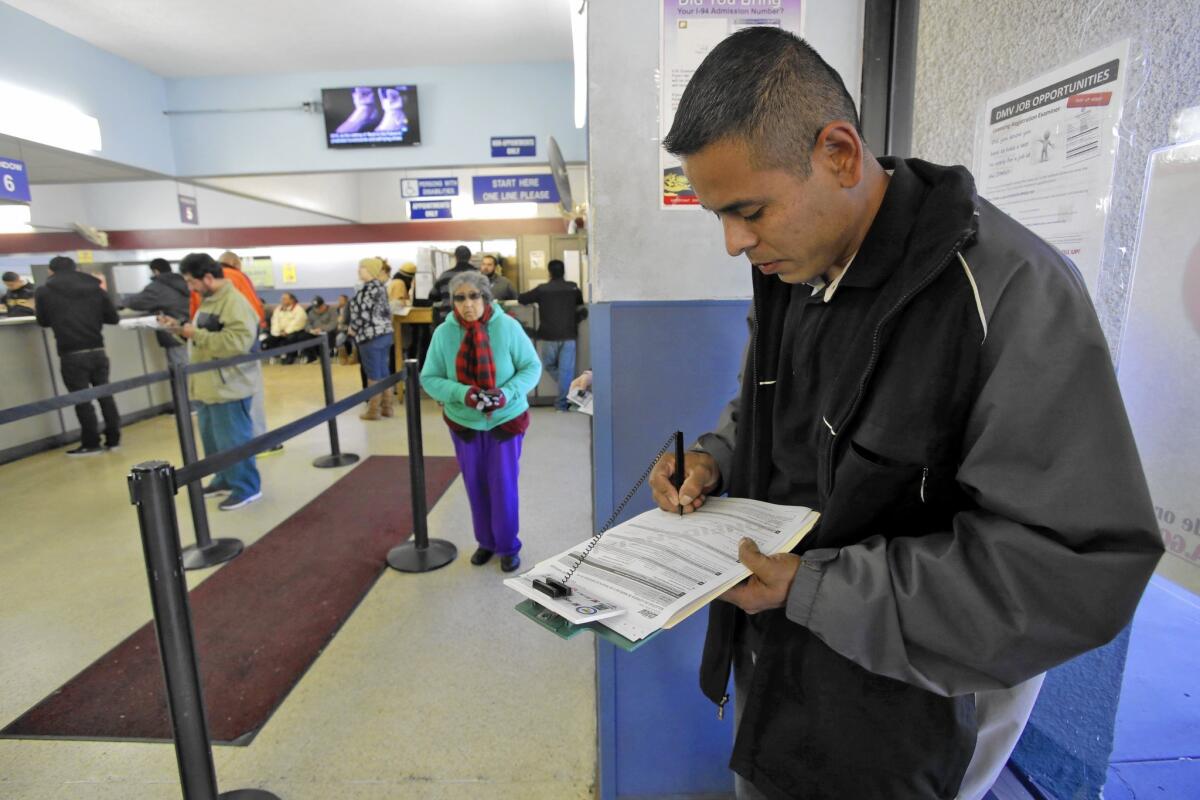There’s been a boom in driver’s licenses issued to immigrants here illegally

- Share via
Judith Benitez had gone most of her adult life without knowing how to drive.
The 35-year-old woman from Mexico who is in the U.S. illegally would ask family members for rides to pick up her children from school. Trips to the grocery store or the doctor’s office were complicated.
That changed last year when Assembly Bill 60 was implemented, granting people in the country illegally the right to obtain driver’s licenses in California. Benitez, who lives in Lemon Grove, learned to drive and was among those in line at the Department of Motor Vehicles the day the law took effect.
“Truthfully, it was an extremely emotional time because having a [driver’s] license isn’t just any little thing,” she said. “We feel a little more protected.”
An estimated 605,000 licenses were issued under the law last year, accounting for nearly half of all new licenses, according to the California DMV. Nearly 400,000 of the licenses were issued during the first six months.
“We believe that this new law increases safety on California roads by putting licensed drivers behind the steering wheel,” spokesman Artemio Armenta said.
Gov. Jerry Brown signed the measure into law in 2013, further establishing California as a national leader on immigrant rights. The legislation was authored by Assemblyman Luis Alejo (D-Salinas), the son of farmworkers.
Brown in August signed a trio of immigration-related measures, which included elimination of the word “alien” within California’s labor code to describe immigrants in the country illegally. The new laws also included allowing noncitizen high school students to serve as election poll workers and protecting immigrant minors in civil lawsuits.
Licenses granted under the law have “federal limits apply” printed on them, which means that unlike California law enforcement, law enforcement officers in other states and federal officials aren’t obligated to accept the licenses as a valid form of identification.
State leaders and law enforcement officials have said the law will improve road safety because more drivers will be licensed and be more likely to be insured.
Join the conversation on Facebook >>
Officer Josh Nelson, spokesman for the California Highway Patrol Border Division, said it’s difficult to determine whether improved traffic safety is correlated with the implementation of the law, but said it’s likely.
“Knowing that these drivers are being properly trained in order to get their licenses, it would only make sense that the roads would be safer,” he said.
California is among 12 states that now allow immigrants in the country illegally to obtain driver’s licenses, areas covering an estimated 37% of that population, according to an August report by the Pew Charitable Trusts.
California, at 22%, has the nation’s largest percentage of immigrants in the country illegally who are eligible for driver’s licenses, according to Pew.
Critics say immigrants in the country illegally shouldn’t be given the privilege of obtaining licenses because they broke the law by entering the country. States such as California are only facilitating illegal immigration, they argue.
Other states such as Florida, New Jersey and Georgia have considered whether immigrants in the country illegally are entitled to driver’s licenses, a rite of passage deeply rooted in American culture.
In the year before the California law was implemented , the DMV hired 1,000 temporary employees and opened four additional processing centers. It also extended hours of operation to include Saturdays.
“The demand at the beginning of the year was very high because we had literally done more than 200 outreach events across the state. We were all hands on deck,” Armenta said.
The DMV has since resumed regular office hours and only 200 temporary employees will remain by the 2016-2017 fiscal year.
Erika Paz emigrated from Mexico in 1987, but her visa expired soon after. Though she obtained her driver’s license seven years ago as a permanent resident and is now a U.S. citizen, Paz created a public Facebook group to help community members exchange tips about the driver’s license law.
The group, Preparándonos para las Licencias, or Preparing Ourselves for Licenses, has garnered about 18,000 followers since its creation in 2014.
“Community members have become very helpful toward each other, to the point where the person who gets their license is willing to help another person by either lending them their car or driving them to the DMV to take their test,” Paz said.
Maribel Solache joined the thousands of other immigrants in the country illegally who lined up at the DMV early Jan. 2, 2015, the first day licenses became available. She recalls a chaotic scene with long lines, limited staff and a downed computer system.
“There was a big resistance and fear but upon getting to the DMV and seeing the diversity of people there, I felt like I wasn’t the only one in that situation,” she said in Spanish.
The San Marcos resident passed her written exam on the first attempt and her driving exam 10 days later. Within a week, she had her license. Today Solache, a former attorney from Mexico City, leads small study groups in which she helps others navigate the license application process.
Sanchez is a staff writer for the San Diego Union-Tribune.
ALSO
Suffering bobcats, coyotes, owls spur Thousand Oaks neighborhood to rethink war on rats
Arrests in 1989 El Salvador priest massacre elicit shock, happiness — and a hope for justice
6th Street Bridge before and after
More to Read
Sign up for Essential California
The most important California stories and recommendations in your inbox every morning.
You may occasionally receive promotional content from the Los Angeles Times.










